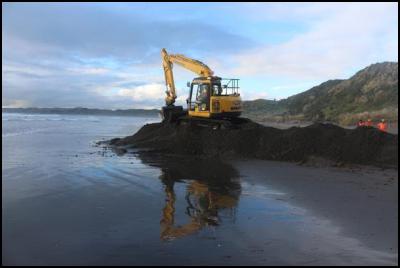TGA cable landing works in Raglan now complete
Media release
14/04/2016
TGA cable landing works in Raglan now complete

- High def video for publication available for download here
- Still images for publication available here
A team of specialist submarine cable experts have successfully laid the first section of the Tasman Global Access (TGA) undersea cable in Raglan.
The cable laying activities at Ngarunui Beach were completed on Friday 8 April.
Telecommunications companies Spark, Vodafone and Telstra are investing approximately USD $70 million to build the TGA cable, which will significantly improve New Zealand’s international broadband connectivity.
Vodafone’s Wholesale Director, Steve Rieger said the 25 strong beach landing project team took one week to bury the three kilometre stretch of heavily armoured cable, which weighs roughly 22 tonnes.
“The team began by pulling the cable ashore from the specialised ship, the MV Tranquil Image. They then stripped a section of the steel armour back to uncover the four fibres inside, which are connected to the terminal station in Raglan and will be connected to Vodafone’s AquaLink cable. This cable already lands at the edge of Ngarunui Beach and will be used to carry TGA traffic to two locations in Auckland – one on the Spark network, and the other on Vodafone’s.
“The team then excavated roughly 5000 square metres of sand and hard clay to bury the cable to a depth of about three metres beneath the sand. During this process, an articulated protective pipe weighing more than 16 kilograms per metre was applied to the cable for extra protection.The remaining stretch of cable was buried to a depth of roughly one metre out into the ocean,” said Steve.
Once it is in service the benefits of the TGA cable will include strengthened links into fast-growing Asian markets, important redundancy and resiliency, and better connection with the five main international cable systems currently serving Australia.
Spark’s General Manager Wholesale and International, Lindsay Cowley said, “During the course of the Raglan shore-end cable lay experts from as far away as Greece worked alongside excavators and builders from the local Raglan community. Together they have successfully completed the first phase of this important engineering project.
“The TGA project team collaborated with local Iwi, council and other groups to ensure this activity had no lasting impact on the environment, and we wish to once again thank the Raglan community for their support and understanding throughout the duration of the works,” said Lindsay.
The work in Raglan marks a significant milestone on the journey to having the TGA cable ready to start carrying data across the Tasman towards the end of 2016.
The TGA cable project is currently on track to be completed, tested and ready for service by the end of 2016. The 2,300 kilometre length of cable is comprised of two fibre pairs, and will have a total capacity of 20 terabits per second.
Further TGA cable project details are as follows:
Constructor: Alcatel-Lucent Submarine Networks (ASN)
Project term: The Raglan shore end works are now complete. The start date for stage two – the cable lay across the Tasman to Narrabeen Beach in Australia – will follow on through a suitable marine window and will also be subject to weather conditions and ASN’s scheduling of marine operations.
• The footage of the
Ngarunui Beach shows specialist submarine cable experts
successfully laying the first section of the Tasman Global
Access (TGA) undersea cable off Raglan’s Ngarunui
Beach.
• The consortium of Spark, Vodafone and Telstra have contracted Alcatel-Lucent Submarine Networks (ASN), now part of Nokia, to lay the TGA cable between Ngarunui Beach at Raglan and Narrabeen Beach in Australia.
• The Tasman Global Access (TGA) cable will meet future international bandwidth requirements for New Zealand consumers and businesses alike, which are set to grow by 11,000% in the next 10 years.
• The TGA landing at Raglan on our West Coast provides important cable route diversity to the existing Southern Cross cable connecting New Zealand to Australia and the USA.
• The TGA cable will enable New Zealand to better leverage the five main international cable systems currently serving Australia, and deliver important redundancy for New Zealand, as well as strengthening links into fast-growing Asian markets.
• Both Spark and Vodafone’s trans-Tasman internet traffic has grown from just 10 percent of total international traffic in 2000, to 40-50 percent today.
• With New Zealand’s international capacity requirements growing 60 percent year-on-year, (and projected 11,000% growth over 10 years) the TGA cable will support the future needs of consumers and the growth aspirations of New Zealand businesses.
• In planning the TGA cable, particular care has been given to ensuring the work at Raglan has minimal impact. All major cable-laying work has been completed “off season” to minimise disruption to regular beach users. The consortium has taken advice from Raglan based marine ecologists regarding the cable route to shore. Local Iwi have also been consulted regarding their knowledge of the area and will continue to be involved in the completion of the project.
ENDS


 Trade Me Property: Voting Is Open! Trade Me Property People’s Choicest Finalists Announced
Trade Me Property: Voting Is Open! Trade Me Property People’s Choicest Finalists Announced Auckland Transport: Auckland Transport Simplifies Fare Structure And Announces Annual Adjustment
Auckland Transport: Auckland Transport Simplifies Fare Structure And Announces Annual Adjustment PETA: PETA Statement On MPI Investigation Into Abuse In The Wool Industry
PETA: PETA Statement On MPI Investigation Into Abuse In The Wool Industry Ministry For Primary Industries: MPI Completes First Phase Of Investigation Into Alleged Animal Welfare Breaches
Ministry For Primary Industries: MPI Completes First Phase Of Investigation Into Alleged Animal Welfare Breaches MBIE: Over 35,000 Non-Compliant Radio Product Listings Removed From Online Marketplaces
MBIE: Over 35,000 Non-Compliant Radio Product Listings Removed From Online Marketplaces  Thrive Whanganui: Empowering Entrepreneurs With Disabilities - Launching February 2025
Thrive Whanganui: Empowering Entrepreneurs With Disabilities - Launching February 2025



